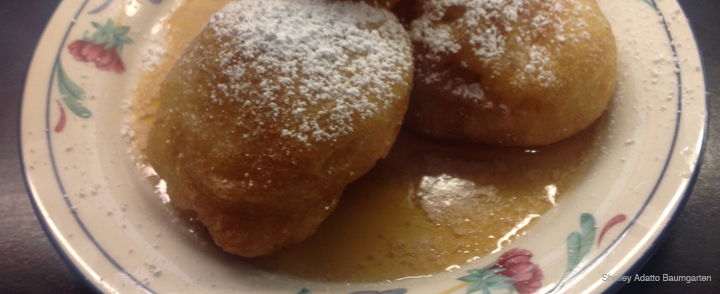By Shelley Adatto Baumgarten, Special to the Jewish Sound
“What makes a fried donut a birmuelo?” I recall my then 9-year-old daughter asking me at the beginning of the eight-day festival of Hanukkah. A birmuelo, I explained to her, is not simply a donut made from flour, water, yeast, sugar and salt with honey or syrup drizzled over it. A birmuelo is a Sephardic dessert delicacy that I learned to make from my grandmother who came from the island of Marmara, Turkey.
Although made from modest ingredients, there is so much more to them: Tradition, history, community, cultural values and pride — lots of it. All of this is conjured up and symbolically represented in this sweet little puff ball we deep fry in vegetable oil.
Sometimes I think I make way too much of the Sephardic culinary tradition I dearly love and deeply respect. Perhaps. However, growing up in the Seattle Turkish-Jewish neighborhood located in Seward Park, I have distinct and fond memories of sampling truly extraordinary birmuelos made by so many great female cooks in my community.
In this community, women made birmuelos from the time they immigrated to Seattle in the early 20th century from Marmara and the cities of Tekirdag and Istanbul. While the men were out fishing, working as merchants, or studying, the women would produce food, glorious food. According to Claudia Roden, in her seminal work on Jewish cuisine, “The Book of Jewish Food,” Jewish women were considered “high priestesses because of their coveted role in the kitchen.”
They kept right in step with their ancestors, bringing the art of preparing and cooking birmuelos to their new life in Seattle. The ingredients they used were very much the same they used in Turkey: White flour, originating in 15th-century Spain, yeast, which goes back to the first century, and sugar, which widely appeared in the medieval Islamic world and was brought to Spain by traders in the 14th century. And oil, for deep-frying. A great deal of it.
The Ladino word birmuelo derives from the Spanish word for various types of fritters (buñelo). It has many different spellings and pronunciations as well. Depending on which part of the Mediterranean you come from, they are referred to as bimuellos, birmuellos, brumuellos, bilmuellos or bulemas.
The birmuelo reaches far back into history. Although I could not locate any 15th or 16th-century references to the birmuelo, I did discover that they were originally made for Passover (bimuellos de massa or bimuellos of matzoh) and for lifecycle events such as wedding receptions. In later centuries in Mediterranean countries such as Turkey and Greece, birmuelos became associated with Hanukkah, because of the use of oil in their preparation. History tells us that in 165 BCE, upon returning to Jerusalem, Judah Maccabee, after his victorious battle against the Syrian Hellenists and King Antiochus Epiphanes, discovered that pagans had polluted nearly all of the oil vessels in the Temple. However, he found one vessel with its seal left intact. Although it appeared to contain only enough oil to burn for one day, it miraculously burned for eight days.
Sephardic Jews celebrate this oil by using large amounts to deep fry their birmuelos. They are typically eaten with warm honey or syrup and dusted with powered sugar. Many Sephardic sisterhoods and ladies’ auxiliaries across the U.S. and globally produce them every year on Hanukkah.
They thoroughly enjoy treating their families and friends to this scrumptious holiday treat. According to an article by David Gitlitz and Linda Davidson, in the words of a young girl in the 1470s attending a party in Valencia, “Ai, maestro! Gran festal que menjam gallines e bunyois, e arras amb oli I me!” (“Oh master, what a great party! They served hens and fritters with oil and honey!”)
I hope your family loves them as much as mine does. As my Turkish-Jewish grandmother would say before we devoured them: Come con gana! (Eat and enjoy!)
Birmuelos
Adapted from “The Book of Jewish Food” by Claudia Roden
2 tsp. active dry yeast
1 tsp. sugar
About 3 cups warm water (1 cup boiling and 2 cups cold)
3-1/3 cups white all-purpose flour
1/2 tsp. salt
Light vegetable oil for deep frying
Dissolve the yeast and sugar in 1/2 cup of the warm water and let sit 10-15 minutes until frothy. Put the flour in a large bowl, whisk in the salt, then mix in the yeast mixture with a wooden spoon. Gradually add the remaining 2-1/2 cups of warm water, mixing vigorously with a wooden spoon for about 10 minutes. You may not need all the water, as you want the batter to be smooth and elastic. Cover with a damp, warm towel and leave in a warm place to rise for at least 1 hour, then beat the batter once more and let it rise for another hour.
Make the fritters in batches, making certain that the oil is very hot. If not hot enough, the fritters will flatten during frying. Test the oil by dropping in a couple of drops of water. If hot enough, the oil will sizzle. You can also carefully drop in a tiny amount of batter and watch it fry until ready to turn.
Using an ice-cream scoop or a tablespoon, scoop up enough batter to fill the scoop/spoon. Drop the batter into 1-1/2 inches of hot oil. Lower the heat a bit (medium-high is good) to allow the fritters to cook inside while crisping up on the outside. Turn over once to allow uniform golden browning. The shape of the fritters will be irregular rather than perfectly round.
Lift out the fritters out a slotted spoon and drain on paper towels. Serve warm with your choice of syrup, honey, jam, and/or confectionary sugar. They are also good cold.
Serves 6-8.
